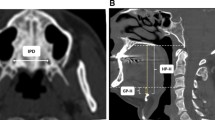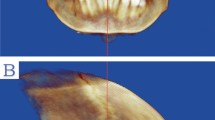Abstract
Background
The integration of anatomical and nonanatomical parameters will improve our ability to predict the outcomes of OSA treatment. Currently, no standardized, quantitative classification of upper airway anatomical traits is available. The retropalatal (RP) airway is the most important area to consider when planning anatomical treatment. However, current evaluation methods feature qualitative conventional endoscopy. Here, we describe a quantitative magnetic resonance imaging (MRI) method used to classify RP airway patterns.
Methods
We recruited 117 males; 20 simple snorers and 97 patients with OSA. Lateral/anteroposterior ratios were calculated in three parallel planes and RP patterns were classified accordingly. Lateral wall soft tissue structures, skeletal dimensions representing those planes, pharyngeal lengths, and skeletal and vertical axis ratios were also measured.
Results
Both the cross-sectional area at the hard palate level and the RP lateral dimension were associated with OSA. OSA patients had longer pharynges than controls. The oblique pattern was associated with narrow lateral dimensions. The vertical pattern was associated with a narrow nasopharynx but a longer pharynx. The airway ratio at the hard palate level and the skeletal ratios of all three planes were negatively correlated with the vertical axis ratio and together explained 40.8% of the variance in the vertical axis ratio.
Conclusions
The data suggest that anatomical imbalances between the craniofacial skeletal and soft tissue structures affect pharyngeal airway morphology in all three dimensions. The dimensions of the nasopharynx, the cross-sectional area at the hard palate level, and pharyngeal length were associated not only with the RP patterns but also with OSA severity. This study affords insights into upper airway anatomy and RP patterns and may help diagnose OSA patients and aid in the selection of an appropriate therapy.




Similar content being viewed by others
References
White DP, Younes MK (2012) Obstructive sleep apnea. Compr Physiol 2:2541–2594. https://doi.org/10.1002/cphy.c110064
Eckert DJ, White DP, Jordan AS, Malhotra A, Wellman A (2013) Defining phenotypic causes of obstructive sleep apnea. Identification of novel therapeutic targets. Am J Respir Crit Care Med 188:996–1004. https://doi.org/10.1164/rccm.201303-0448OC
Eckert DJ (2018) Phenotypic approaches to obstructive sleep apnoea—new pathways for targeted therapy. Sleep Med Rev 37:45–59. https://doi.org/10.1016/j.smrv.2016.12.003
Carberry JC, Amatoury J, Eckert DJ (2018) Personalized management approach for OSA. Chest 153:744–755. https://doi.org/10.1016/j.chest.2017.06.011
Chen H, Aarab G, de Ruiter MH, de Lange J, Lobbezoo F, van der Stelt PF (2016) Three-dimensional imaging of the upper airway anatomy in obstructive sleep apnea: a systematic review. Sleep Med 21:19–27. https://doi.org/10.1016/j.sleep.2016.01.022
Chai-Coetzer CL, Antic NA, Rowland LS, Reed RL, Esterman A, Catcheside PG, Eckermann S, Vowles N, Williams H, Dunn S, McEvoy RD (2013) Primary care vs specialist sleep center management of obstructive sleep apnea and daytime sleepiness and quality of life: a randomized trial. JAMA 309:997–1004. https://doi.org/10.1001/jama.2013.1823
Trudo FJ, Gefter WB, Welch KC, Gupta KB, Maislin G, Schwab RJ (1998) State-related changes in upper airway caliber and surrounding soft-tissue structures in normal subjects. Am J Respir Crit Care Med 158:1259–1270
Leiter JC (1996) Upper airway shape: is it important in the pathogenesis of obstructive sleep apnea? Am J Respir Crit Care Med 153:894–898
Chan AS, Lee RW, Srinivasan VK, Darendeliler MA, Grunstein RR, Cistulli PA (2010) Nasopharyngoscopic evaluation of oral appliance therapy for obstructive sleep apnoea. Eur Respir J 35:836–842. https://doi.org/10.1183/09031936.00077409
Safiruddin F, Vanderveken OM, de Vries N, Maurer JT, Lee K, Ni Q, Strohl KP (2015) Effect of upper-airway stimulation for obstructive sleep apnoea on airway dimensions. Eur Respir J 45:129–138. https://doi.org/10.1183/09031936.00059414
Pang KP, Woodson BT (2013) Current concepts in evaluation and surgical planning: the Pang–Woodson protocol. In: Pang KP, Woodson BT, Rotenberg B (eds) Advanced surgical technique in snoring and obstructive sleep apnea, 1st edn. Plural Publishing, USA, pp 37–42
Woodson BT (2008) Structural effectiveness of pharyngeal sleep apnea surgery. Sleep Med Rev 12:463–479. https://doi.org/10.1016/j.smrv.2008.07.010
Li HY, Chen NH, Wang CR, Shu YH, Wang PC (2003) Use of 3-dimensional computed tomography scan to evaluate upper airway patency for patients undergoing sleep-disordered breathing surgery. Otolaryngol Head Neck Surg 129:336–342. https://doi.org/10.1016/S0194-59980300629-6
Ryan CF, Lowe AA, Li D, Fleetham JA (1991) Three-dimensional upper airway computed tomography in obstructive sleep apnea. A prospective study in patients treated by uvulopalatopharyngoplasty. Am Rev Respir Dis 144:428–432. https://doi.org/10.1164/ajrccm/144.2.428
Cahali MB, Formigoni GG, Gebrim EM, Miziara ID (2004) Lateral pharyngoplasty versus uvulopalatopharyngoplasty: a clinical, polysomnographic and computed tomography measurement comparison. Sleep 27:942–950
Denolf PL, Vanderveken OM, Marklund ME, Braem MJ (2016) The status of cephalometry in the prediction of non-CPAP treatment outcome in obstructive sleep apnea patients. Sleep Med Rev 27:56–73. https://doi.org/10.1016/j.smrv.2015.05.009
Woodson BT (2015) A method to describe the pharyngeal airway. Laryngoscope 125:1233–1238. https://doi.org/10.1002/lary.24972
Woodson BT, Sitton M, Jacobowitz O (2012) Expansion sphincter pharyngoplasty and palatal advancement pharyngoplasty: airway evaluation and surgical techniques. Oper Tech Otolaryngol Head Neck Surg 23:3–10. https://doi.org/10.1016/j.otot.2012.01.002
Woodson BT (2013) Palatal advancement pharyngoplasty. In: Pang KP, Woodson BT, Rotenberg B (eds) Advanced surgical technique in snoring and obstructive sleep apnea, 1st edn. Plural Publishing, USA, pp 167–177
Iber C, Ancoli-Israel S, Chesson A, Quan S (2007) The AASM manual for the scoring of sleep and associated events: rules, terminology and technical specifications. American Academy of Sleep Medicine, Westchester
Berry RB, Budhiraja R, Gottlieb DJ, Gozal D, Iber C, Kapur VK, Marcus CL, Mehra R, Parthasarathy S, Quan SF, Redline S, Strohl KP, Ward SLD, Tangredi MM (2012) Rules for scoring respiratory events in sleep: update of the 2007 AASM manual for the scoring of sleep and associated events. J Clin Sleep Med 8:597–619. https://doi.org/10.5664/jcsm.2172
Muto T, Takeda S, Kanazawa M, Yamazaki A, Fujiwara Y, Mizoguchi I (2002) The effect of head posture on the pharyngeal airway space (PAS). Int J Oral Maxillofac Surg 31:579–583. https://doi.org/10.1016/j.ijom.2007.12.012
Abdullah VJ, Koutsourelakis I, Ravesloot MJL, Lip Yen Lee D, Ching Nam Ha S, van Hasselt CA et al (2013) Drug-induced sleep endoscopy. In: Pang KP, Woodson BT, Rotenberg B (eds) Advanced surgical technique in snoring and obstructive sleep apnea, 1st edn. Plural Publishing, USA, pp 43–65
Watanabe T, Isono S, Tanaka A, Tanzawa H, Nishino T (2002) Contribution of body habitus and craniofacial characteristics to segmental closing pressures of the passive pharynx in patients with sleep-disordered breathing. Am J Respir Crit Care Med 165:260–265. https://doi.org/10.1164/ajrccm.165.2.2009032
Finkelstein Y, Shapiro-Feinberg M, Talmi YP, Nachmani A, DeRowe A, Ophir D (1995) Axial configuration of the velopharyngeal valve and its valving mechanism. Cleft Palate Craniofac J 32:299–305. https://doi.org/10.1597/1545-1569(1995)032<0299:ACOTVV>2.3.CO;2
Enlow DH (1982) Handbook of facial growth, 2nd edn. WB Saunders Company, Philadelphia
Davidson TM (2003) The great leap forward: the anatomic basis for the acquisition of speech and obstructive sleep apnea. Sleep Med 4:185–194
Yamashiro Y, Kryger M (2012) Is laryngeal descent associated with increased risk for obstructive sleep apnea? Chest 141:1407–1413. https://doi.org/10.1378/chest.10-3238
Woodson BT, Conley SF (1997) Prediction of uvulopalatopharyngoplasty response using cephalometric radiographs. Am J Otolaryngol 18:179–184
Doghramji K, Jabourian ZH, Pilla M, Farole A, Lindholm RN (1995) Predictors of outcome for uvulopalatopharyngoplasty. Laryngoscope 105:311–314. https://doi.org/10.1288/00005537-199503000-00016
Millman RP, Carlisle CC, Rosenberg C, Kahn D, McRae R, Kramer NR (2000) Simple predictors of uvulopalatopharyngoplasty outcome in the treatment of obstructive sleep apnea. Chest 118:1025–1309
Genta PR, Schorr F, Eckert DJ, Gebrim E, Kayamori F, Moriya HT, Malhotra A, Lorenzi-Filho G (2014) Upper airway collapsibility is associated with obesity and hyoid position. Sleep 37:1673–1678. https://doi.org/10.5665/sleep.4078
Carlisle T, Carthy ER, Glasser M, Drivas P, McMillan A, Cowie MR, Simonds AK, Morrell MJ (2014) Upper airway factors that protect against obstructive sleep apnoea in healthy older males. Eur Respir J 44:685–693. https://doi.org/10.1183/09031936.00177213
Chan AS, Sutherland K, Schwab RJ, Zeng B, Petocz P, Lee RW, Darendeliler MA, Cistulli PA (2010) The effect of mandibular advancement on upper airway structure in obstructive sleep apnoea. Thorax 65:726–732. https://doi.org/10.1136/thx.2009.131094
Van de Graaff WB, Gottfried SB, Mitra J, van Lunteren E, Cherniack NS, Strohl KP (1984) Respiratory function of hyoid muscles and hyoid arch. J Appl Physiol Respir Environ Exerc Physiol 57:197–204
Chi L, Comyn FL, Keenan BT, Cater J, Maislin G, Pack AI, Schwab RJ (2014) Heritability of craniofacial structures in normal subjects and patients with sleep apnea. Sleep 37:1689–1698
Huynh NT, Desplats E, Almeida FR (2016) Orthodontics treatments for managing obstructive sleep apnea syndrome in children: a systematic review and meta-analysis. Sleep Med Rev 25:84–94
Abramson Z, Susarla SM, Lawler M, Bouchard C, Troulis M, Kaban LB (2011) Three-dimensional computed tomographic airway analysis of patients with obstructive sleep apnea treated by maxillomandibular advancement. J Oral Maxillofac Surg 69:677–686. https://doi.org/10.1016/j.joms.2010.11.037
Zaghi S, Holty JE, Certal V, Abdullatif J, Guilleminault C, Powell NB et al (2016) Maxillomandibular advancement for treatment of obstructive sleep apnea: a meta-analysis. JAMA Otolaryngol Head Neck Surg 142:58–66. https://doi.org/10.1001/jamaoto.2015.2678
Malhotra A, Orr JE, Owens RL (2015) On the cutting edge of obstructive sleep apnoea: where next? Lancet Respir Med 3:397–403. https://doi.org/10.1016/S2213-2600(15)00051-X
Chi L, Comyn FL, Mitra N, Reilly MP, Wan F, Maislin G, Chmiewski L, Thorne-FitzGerald MD, Victor UN, Pack AI, Schwab RJ (2011) Identification of craniofacial risk factors for obstructive sleep apnoea using three-dimensional MRI. Eur Respir J 38:348–358. https://doi.org/10.1183/09031936.00119210
Owens RL, Edwards BA, Eckert DJ, Jordan AS, Sands SA, Malhotra A, White DP, Loring SH, Butler JP, Wellman A (2015) An integrative model of physiological traits can be used to predict obstructive sleep apnea and response to non positive airway pressure therapy. Sleep 38:961–970
Li Y, Ye J, Han D, Cao X, Ding X, Zhang Y, Xu W, Orr J, Jen R, Sands S, Malhotra A, Owens R (2017) Physiology-based modeling may predict surgical treatment outcome for obstructive sleep apnea. J Clin Sleep Med 13:1029–1037. https://doi.org/10.5664/jcsm.6716
Funding
This study was supported by the Baskent University Research Fund (project no. KA17/36).
Author information
Authors and Affiliations
Corresponding author
Ethics declarations
Conflict of interest
The authors declare that they have no conflict of interest.
Ethical approval
All procedures involving human participants were performed in accordance with the ethical standards of our institutional and/or national research committee and with those of the 1964 Helsinki declaration and later amendments, or comparable ethical standards.
Informed consent
Informed consent was obtained from all participants.
Rights and permissions
About this article
Cite this article
Avci, S., Lakadamyali, H., Lakadamyali, H. et al. Relationships among retropalatal airway, pharyngeal length, and craniofacial structures determined by magnetic resonance imaging in patients with obstructive sleep apnea. Sleep Breath 23, 103–115 (2019). https://doi.org/10.1007/s11325-018-1667-x
Received:
Revised:
Accepted:
Published:
Issue Date:
DOI: https://doi.org/10.1007/s11325-018-1667-x




